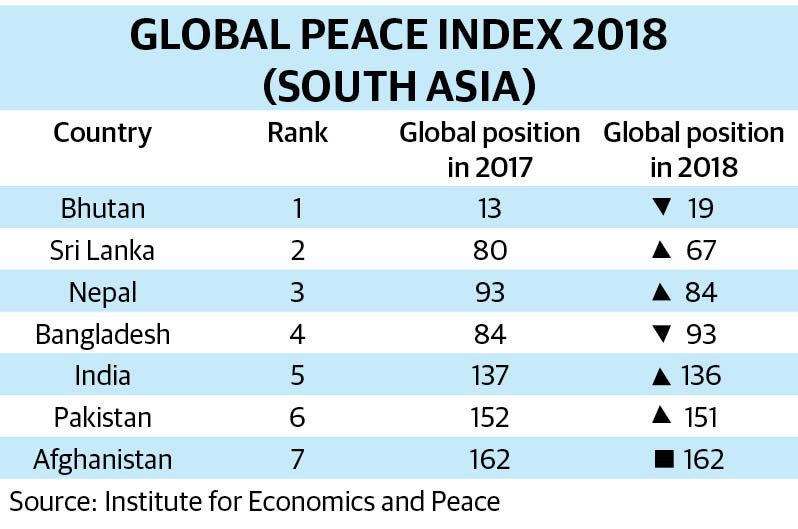India is one of the most peaceful nations of the world, it has been declared 28th worst peaceful nation ranking 136th out of 163 nations measured for peacefulness by the Global Peace Index 2018. In comparison to last year, India scored only a little better by 0.025 pushing its rank up by four from 140th rank. A report, for Different Truths.
Against the popular belief among Indians that India is one of the most peaceful nations of the world, it has been declared 28th worst peaceful nation ranking 136th out of 163 nations measured for peacefulness by the Global Peace Index 2018. In comparison to last year, India scored only a little better by 0.025 pushing its rank up by four from 140th rank. The country’s overall score is 2.504 on a scale of 0-10.
The slightly improved overall score for India was due to the government’s efforts to tackle violent crime, falling levels of military expenditure, particularly on weapons imports, resulting in an improvement in its militarisation score. However, the concentration of power in the office of Prime Minister Narendra Modi led to the deterioration in India’s score for political instability, and the country’s scores on the political terror scale and internal conflicts, at 4 and 4.7 respectively, remain elevated, says the report.
While referring to South Asia, the report said that the strengthening scores on the political terror scale, refugees and IDPs, and terrorism impact were partially offset by deterioration in external conflicts after a border dispute with China flared in the Doklam Pass. The three-month standoff involved India, which sent troops to the area.
On relations with the neighbouring countries, the report said that India kept the peace until 1980 but it declined since then. Diplomatic exchanges increased but at a much slower rate. China maintained a lower number of diplomatic exchanges until surpassing Russia and India in 1980. India in thus far behind China in diplomatic exchanges, which is not only a tool for deterrence against other countries, but also for conflict prevention, apart from other economic and political benefits.
On safety and security, the report said that India’s military personnel rate almost tripled in the 1960s and the 1970s, but has since declined slowly. It reflects the changing nature of warfare, which increasingly relies on technological strength rather than the sheer number of personnel. In this context it refers to successful detonation of nuclear weapons by India among Pakistan and North Korea, the countries which did not sign on the Treaty for the Non-Proliferation of Nuclear Weapons (NPT) of 1970 or have withdrawn since signing. India is estimated to have around 700 nuclear weapons in 2015 compared to around 800 the previous year.
In the GPI domain score, relating to ongoing domestic and international conflict, India scores 2.826 securing the position of the 17th worst country in the world. Syria is presently the worst country. Afghanistan and Pakistan are 2nd and 4th worst countries. All other countries in South Asia are faring better than India.
On societal safety and security, India scores 2.356, which is indicative of the fact that the country needs to give more attention to improve the situation. The scores of the majority of the countries of the world have been deteriorating on this account. Therefore, in comparison to other countries, it ranks 60th in the world. This rank is not a matter of satisfaction for India, because its score is still higher enough to make people miserable with great sufferings.
On militarisation, India scores 2.413, ranking as the 16th most militarised country. It means, in terms of peacefulness, that India is the 16th worst country in the world. Israel is the worst in peacefulness with most militarised status. Afghanistan and Pakistan are even more militarized than India, being at 14th and 12th in the world. In other words, Pakistan and Afghanistan are 12th and 14th worst peaceful countries in terms of militarization. Keeping in mind the legacy of conflicts between India and Pakistan, the militarization of both the countries to such a high degree is a cause of great concern not only for both the countries, but also for South Asia and the word.
The GPI has also estimated the cost of violence. The economic cost of violence for India was 806,236.9 million dollars in 2017 while the economic impact was of 1,190,509.6 million dollars. As a percentage of GDP of the country, the total cost of violence was 9 percent, ranking 59th in the world. The per capita loss due to violence was 595.4 dollars.
It is of great concern that global peacefulness has deteriorated by 2.38 percent since 2008. It deteriorated for eight of the last eleven years, with the last improvement in peacefulness occurring in 2014. The current year is thus the fourth successive year of deterioration.
Global Peace Index is prepared by the Institute for Economics & Peace headquartered in Sydney. It is an independent, non-partisan, non-profit think tank dedicated to shifting the world’s focus to peace as a positive, achievable, and tangible measure of human well-being and progress. The GPI covers 99.7 percent of the world’s population, using 23 qualitative and quantitative indicators from highly respected sources, and measures the state of peace using three thematic domains: the level of Societal Safety and Security; the extent of Ongoing Domestic and International Conflict; and the degree of militarisation.
Gyan Pathak
©IPA Service
Photo from the Internet



